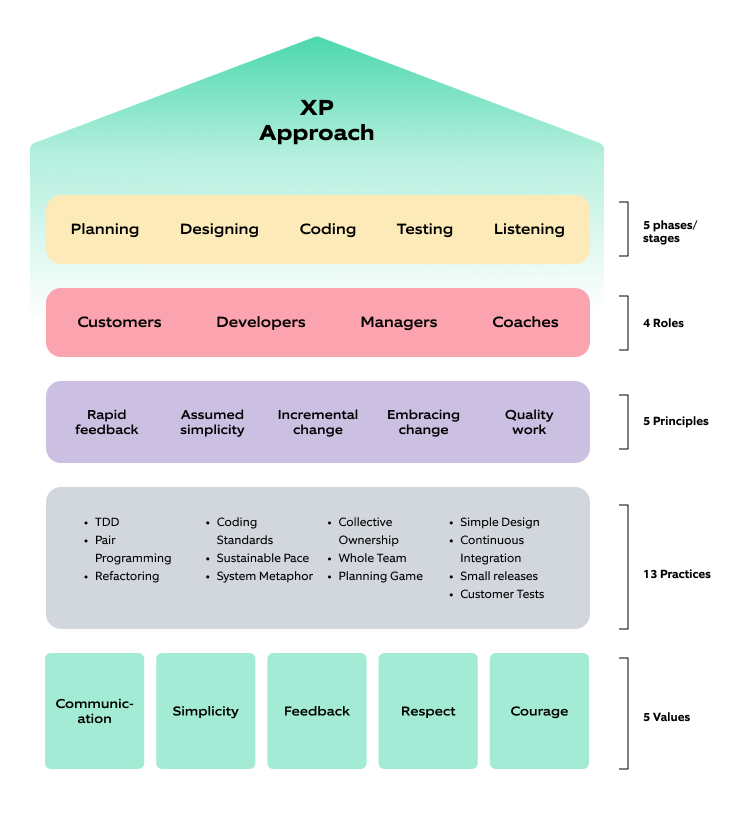Software development is a dynamic industry where innovation is key, and keeping up with the latest trends and buzzwords is crucial to success. But amidst the constant buzz, we often overlook the tried-and-tested methods that have proven their worth time and again.
Enter Extreme Programming (XP), an Agile methodology that has existed since the late 1990s and has stood the test of time. Despite the emergence of newer methodologies, XP remains a relevant and effective way to develop software. Its principles of continuous improvement, customer collaboration, and iterative development have proven to be timeless, which has made it an essential tool for any software development team looking to achieve success. So if you want to keep up with the latest trends without sacrificing the tried and true, give Extreme Programming a shot – you won't be disappointed!
Extreme what?
Extreme Programming (XP) began as an agile software development methodology in the late 1990s. At that time, software development was often seen as a rigid, bureaucratic process that involved a lot of documentation and meetings but with minimal actual coding. This approach did not meet the rapidly changing business environment of the time, which required software development teams to be more flexible and adaptable. And thus came XP!
In response to these challenges, a software engineer named Kent Beck developed XP. Beck had previously worked on the development of Smalltalk, one of the very first object-oriented programming languages. He was frustrated with the slow pace of software development and wanted to create a methodology that would enable teams to deliver working software more quickly and efficiently.
The first edition of Beck's book “Extreme Programming Explained: Embrace Change” was published in 1999, and it quickly gained a following among software developers who were looking for a better way of working. XP emphasized several key practices like test-driven development, pair programming, continuous integration, and frequent releases. These practices were designed to enable teams to work collaboratively, iterate quickly, and deliver software that met the needs of the customer.
 In short, Extreme Programming is like taking all the vital practices of agile software development and turning their volume up to 120%.
In short, Extreme Programming is like taking all the vital practices of agile software development and turning their volume up to 120%.
Like all good things, XP has evolved and matured over the years, ever since its introduction. It has been adopted by a wide range of organizations in industries ranging from finance to healthcare to gaming. Despite the emergence of newer agile methodologies like Scrum and Kanban, XP remains a relevant and valuable approach to software development. It is extremely well-suited for agile teams that prioritize collaboration, feedback, and continuous improvement. Even more because it is the only agile methodology that focuses on technical excellence and software engineering practice in such great detail where others, like Scrum, are yet to fill a huge void.
Why is Extreme Programming still relevant?
Nurtures collaboration: XP emphasizes the importance of continuous feedback, communication, and teamwork. These values are still critical in modern software development, and XP provides a framework for achieving them. Additionally, XP promotes practices like test-driven development (TDD), pair programming, and continuous integration, which have been shown to improve software quality and reduce defects.
Breaks down complexity: XP is also well-suited for developing complex software systems. With its emphasis on iterative development, XP allows teams to break large projects into smaller, more manageable pieces. This makes it easier to test and debug code while it's being developed, which reduces the risk of errors creeping into the codebase.
Furthermore, XP is adaptable to a wide range of project sizes and types. Whether you're working on a small internal tool or a large-scale enterprise application, XP provides a flexible framework for developing software that meets the customer's needs.
Testing is more important than ever before: With the rise of DevOps and continuous delivery, testing has become a vital component of software development. Teams must test their code early and often to catch bugs and ensure the software works as intended. XP's emphasis on Test-Driven Development (TDD) is still relevant today, as it provides a framework for writing tests before writing the code. TDD ensures that the code is testable and helps to catch bugs soon enough in the development cycle.
Continuous Integration & Automation is Essential: Continuous Integration (CI) involves regularly integrating any code changes into a shared repository and testing them automatically. CI ensures that code changes do not introduce bugs or break existing functionality. XP's emphasis on frequent releases and continuous integration is still relevant even today because it enables teams to detect and fix issues quickly. With CI, teams can catch bugs early in the development cycle and avoid costly rework later on.
Customer involvement is key: XP's emphasis on customer involvement is still relevant today, as it ensures that the software meets the customer's needs. In today's fast-paced and complex software development landscape, involving customers in the development process is more important than ever. By involving customers early and often, teams can ensure that they are developing software that meets the customer's needs and avoids costly rework later on. XP's emphasis on customer involvement helps to ensure that the software is being developed in the right direction.
Simplicity is still a virtue: Why is XP's emphasis on simplicity still so relevant? That is because it ensures that the software is easy to maintain and modify. In today's fast-paced and complex software development landscape, this is a key attribute in developing any software. XP's emphasis on simplicity helps ensure that the code is easy to understand, modify, and maintain, thus saving time and money in the long run.
Benefits of using Extreme Programming (XP)
One of the primary benefits of XP is its emphasis on testing. TDD requires developers to write automated tests for their code before they begin writing the code itself. This ensures that the code is written with testability in mind and reduces the likelihood of introducing defects into the codebase. Additionally, XP emphasizes continuous integration, which involves automatically building and testing the code every time a change is made. This helps to catch defects early in the development process, making them easier and less expensive to fix.
Another benefit of XP is its strong reliance on communication and collaboration. Pair programming, in which two developers get to work together on one computer, promotes knowledge sharing and ensures that the code is written correctly. XP also encourages customer involvement in the development process, which also ensures that the software meets the customer's needs.
Finally, Extreme Programming promotes a culture of continuous improvement. By constantly seeking feedback and looking for ways to improve, XP teams can deliver software that meets the customer's needs more effectively and efficiently.
Conclusion
Despite the emergence of newer methodologies, Extreme Programming (XP) remains a timeless and effective way to develop software. Its emphasis on collaboration, iterative development, testing, customer involvement, and simplicity makes it an ideal fit for modern software development. XP's focus on technical excellence and software engineering practices also distinguishes itself from other agile methodologies.
If you're interested in revisiting XP practices for your team, get in touch with us. Our "Technical Excellence" offering provides a comprehensive curriculum based on XP principles and can help your team unlock its full potential. Don't hesitate to reach out and take the first step towards achieving greater productivity and success.





